The Special, Behind-the-Scenes Ways Museums Bring Costume Design Exhibits to Life
From performing mannequin surgery to building hidden foundation garments for all the gorgeous gowns in "The Crown."
A typical museum visit offers an immersive, first-hand experience to learn more about, say, fashion's relationship with Catholicism or 18th century Chippendale chairs. But your next culture trip could also include marveling over costumes from your favorite shows, like the royal blue Hartnell ballgown that Claire Foy wore as Queen Elizabeth II, as recreated by Jane Petrie for "The Crown" season 2, or Ane Crabtree's now-iconic blood red cloak and cap from "Handmaid's Tale," which will be officially enshrined in the Smithsonian's permanent collection.
A costume design exhibit is actually so much more than being one degree — or a period evening gown or dashing military uniform — away from that Hollywood star or beloved character; it's also an opportunity to nerd out over the technique, artistry and delightful behind-the-scenes anecdotes into making the costume. Plus, pouring over an exhibit offers a macro look at how costume plays an integral part of a show or movie's storytelling. (And you can take it all in in your own time.)
For museums, planning a costume exhibit starts with a specific theme or goal. The recently concluded "Cinematic Couture" exhibit at the SCAD FASH Museum of Fashion + Film on the Savannah College of Art and Design's Atlanta campus illustrated a fashion history timeline spanning three centuries of costumes (some Oscar-winning) as an educational tool, like the breathtaking 18th century gowns by James Acheson, as worn by Michelle Pfeiffer, Uma Thurman and Glenn Close, in "Dangerous Liaisons" (above). Last year, the museum held a "Dressing for Dystopia" showing how Crabtree's Emmy-nominated costumes for "Handmaid's Tale" used color and detail to delineate class divides in the allegorical drama series. "The Coen Brothers Go West: Costume Design for 'The Ballad of Buster Scruggs" at the Museum of the Moving Image in Queens, New York uses Mary Zophres's Oscar-nominated work to demonstrate the intricate, creative processes behind making the movie.
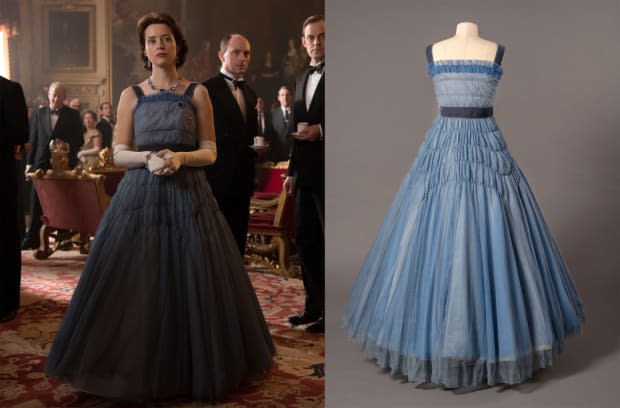
The Winterthur Museum, Garden and Library, a former Du Pont estate in Delaware, branched out from its focus on 17th to 19th century decorative and fine arts in 2015 with its first costume design exhibition, "Costumes of 'Downton Abbey,'" in 2015 for a pretty relatable reason. "Our director was an avid fan," says Estate Historian Jeff Groff. The "Downton" exhibit "paralleled" the culture and lifestyle of the fictional aristocratic Crawleys with the American Du Ponts through wardrobe, architecture and furniture. The museum's sophomore effort, "Costuming 'The Crown,'" which opens on March 30, focuses on the creative and design processes of the Emmy-winning designers Michele Clapton (season one) and Jane Petrie (season two). (The director is a fan of the Netflix series, too.)
But with an embarrassment of iconic costume riches, how does a curator decide which costumes are most representative of the story the museum is trying to tell?
"Iconic pieces are great, but they don't always serve our purpose best to have something that is so instantly recognizable and famous. Sometimes it distracts from how we're trying to teach and what we're trying to convey," says Barbara Miller, Curatorial Director, Museum of the Moving Image, which is dedicated to exploring the history, artistry and techniques behind film, television and digital media. Miller worked closely with the Coen Brothers' longtime designer to select the ensembles, which best detailed the unique storytelling of the anthology movie. For example, as we stood in front of the exhibit, she pointed to the Gene Autrey-inspired Buster Scruggs costume (worn by Tim Blake Nelson, below far right), which exemplified how the script explores Western cinematic tropes.
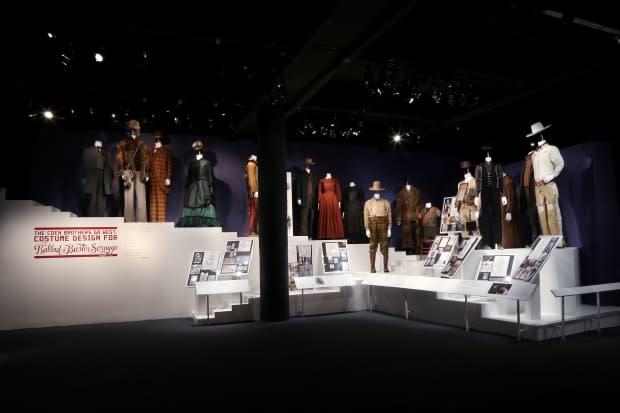
For "Costuming the Crown," Kim Collison, Manager of Exhibitions & Collection Planning at the Winterthur, closely collaborated with Petrie and Clapton to best showcase their design process, incorporate behind-the-scenes anecdotes and determine the final lineup. "Michele said, 'No, I really want this one here," say Collison, over the phone, about including a soft pink off-the-shoulder dress that Princess Margaret (Vanessa Kirby) wears in two meaningful story moments in the first season.
The exhibition will feature famous recreated ensembles, like Queen Elizabeth II's gilded coronation robes and the aforementioned blue dress, but also original designs by the Clapton and Petrie, like the Duchess of Windsor's Schiaparelli and Mainbocher-inspired cardigan and dress set in season one and Margaret's fabulous abstract check coat and scarf look worn for a visit to Tony Armstrong in season two. (Spectacular reproductions of royal crowns and jewels will be featured, too.)
"We had around 50 pieces here, but we maybe could have had 500," says Rafael Gomes, Director of SCAD Fashion Exhibitions, about filtering down his selections for "Cinematic Couture." The exhibit included an expansive collection of movie and TV costumes, including the aforementioned Oscar-winning "Dangerous Liaisons" gowns, Jenny Beavan's 16th century-ish dresses for Drew Barrymore in "Ever After: A Cinderella Story," Michael O'Connor's Oscar-winning 18th century aristocratic ensembles in "The Duchess" and Rosalind Ebbutt's 19th century designs for "Victoria" on the small screen. Gomes, like the Winterthur for "Downton Abbey," worked with London-based costume house Cosprop, which has a dedicated exhibitions department.
Getting the actual costumes to the museum can sometimes be a breeze, like Netflix shipping all the "Buster Scruggs" ensembles straight to Miller. "In other situations, we're in either freezing cold or burning hot storage facilities, opening boxes and combing through things," she says. Curators may source from a mix of costume and rental houses, other museums and studio archives, either on a loan and/or rental basis. (Legal departments may also need to negotiate rights for video or images used in an exhibit.)
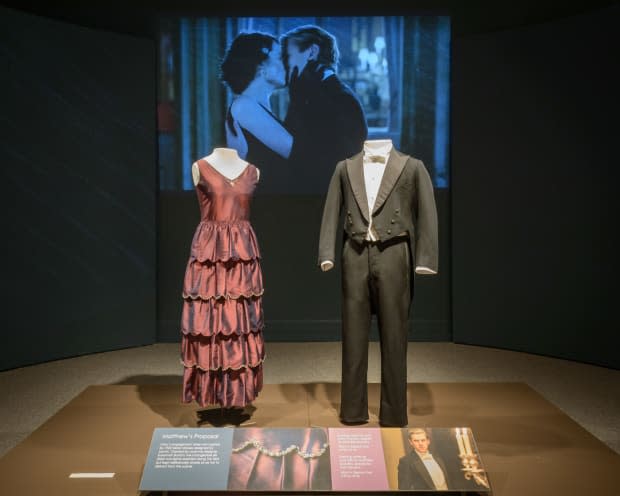
"We have to live up to expectations; make it fun and and visually appealing," says the Winterthur's Groff, about the actual display of the exhibition, which will hopefully evoke that special emotion that brought fans there in the first place. But, more importantly, the exhibit needs to illuminate the intended themes, be it through vignettes recreating famous scenes, like cousin Matthew proposing to Lady Mary in the snow (above), or pared down displays focusing on the designs, rather than the characters.
"It's never appealing for us to approach the exhibition of costumes as if we're trying to make visitors feel like it's the actor wearing them," says Museum of the Moving Image's Miller. "We're not posing them to look like actors. We're creating a neutral palette in terms of exhibition design, so you're looking at these pieces as costumes."
Because a costume, especially an iconic one, is oft-associated with moving character in a pivotal scene, having it resonate in the same way while displayed in a static manner presents another challenge. The foundation is crucial, but a standard form mannequin — or a "six foot four tall fashion" one in the case of SCAD FASH Museum of Fashion + Film — won't work because costumes were built to the exact measurements of the person inhabiting the role. Museum teams may need to get creative, especially when specialty mannequins are out of budget.
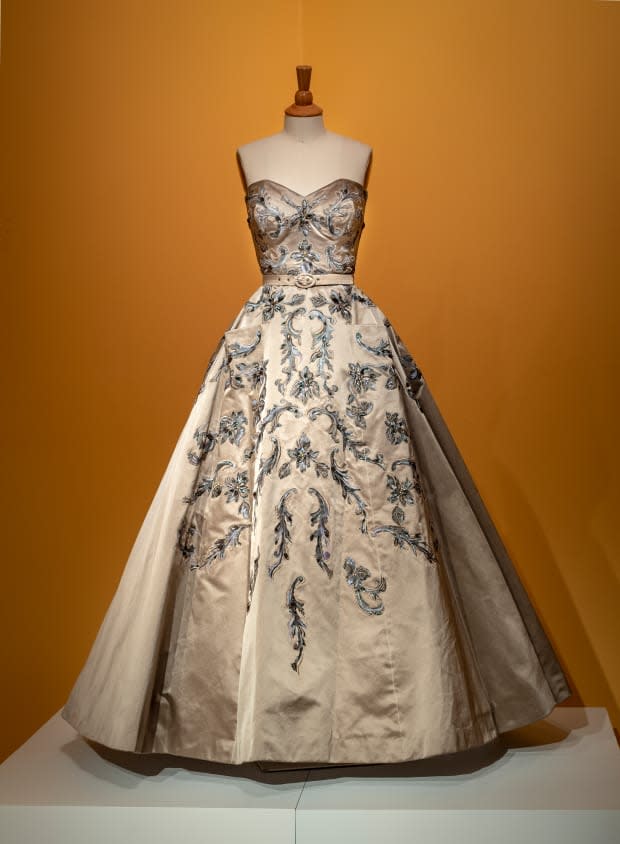
For "Costuming the Crown," the clothes are displayed on linen-covered and wooden finial-topped torso forms, reminiscent of an old-time-y tailor shop (above). "It's a visual reminder for visitors to think about all the work that went into designing and constructing these costumes," says Laura Mina, Associate Conservator of Textiles & Head of Textile Lab, Winterthur Museum.
Each form was custom-padded to perfectly fit the actor's shape, but also mimic their character's stance in any given scene — be it a formal situation in Parliament or a "relaxed" private moment. "If the mannequin doesn't have that same posture, the costume looks really bad," she says. But visible arms or legs on the forms would distract, so Mina built and molded concealed limbs out of Fosshape material to fill out any sleeves, long or short, and necessary pant legs. "It's hidden underneath the garment, so it's not as creepy as Beetlejuice," she laughs.
The "Cinematic Couture" exhibit not only featured costumes custom-built for actors, but also three centuries worth of silhouettes, from corseted Elizabethan shapes to Penny Rose's '50s-era dress that hid Madonna's baby bump in "Evita." So Gomes enlisted SCAD students to essentially perform surgery on cotton-canvas and styrofoam-filled dress forms to recreate the actor's body and the trends of the era.
"We needed to cut into the mannequin — like a Caesarian, literally — and pull up all the skin and then start sculpting the styrofoam inside," Gomes explains. (Related high-level student contribution: The "Victoria" coronation crown wasn't available, so Tina Gancev, a M.A. candidate studying luxury and fashion management, designed and Rhino 3D-printed her own regal version and embellished it with Swarovski-sponsored crystals.)
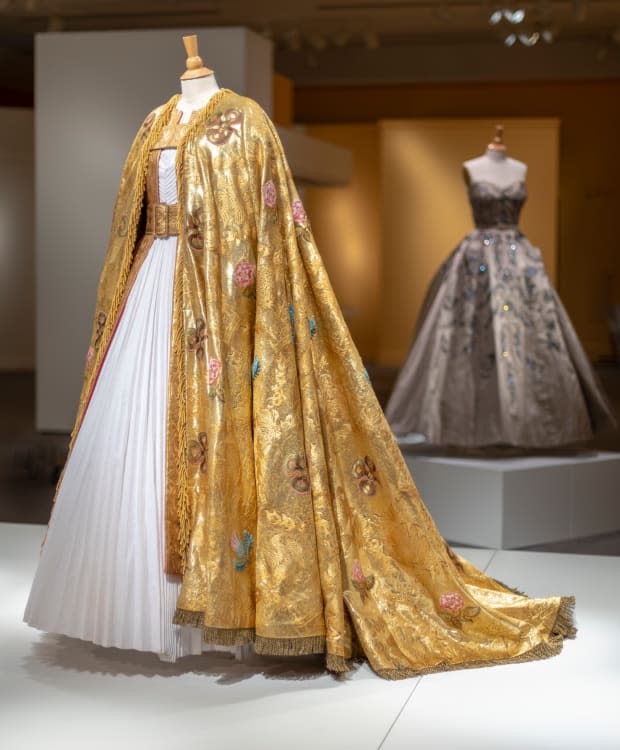
A static display also requires special tricks to make sure a costume originally made for movement stays majestically in place, and keeps its shape, throughout the length of an exhibit. "For me, I don't care about how it moves through space, but I really care about how it moves through time," jokes Mina, who swapped out elastic suspenders for custom-made non-stretch ones to avoid sagging on men's military uniform trousers. To maintain the structure of '50s dresses and royal gowns, Mina created period-incorrect metal hoop skirting, as opposed to using crinoline layers actually worn by the leads. She also built a "fortress-like bustle" foundation to support the considerable weight of the gold coronation robes from the back (above).
Mina notes that the same techniques can be employed for historical clothing exhibits, too, but with one main difference in terms of research. "Part of the fun was re-watching and pausing ['The Crown'] episodes trying to see what the actor looks like in the costume," she says.
"Costuming 'The Crown'" runs from March 30, 2019 to January 5, 2020 at the Winterthur Museum, Garden and Library in Winterthur, Delaware. More details here.
"The Coen Brothers Go West: Costume Design for 'The Ballad of Buster Scruggs'" runs through May 26, 2019 at the Museum of the Moving Image in Queens, New York. More details here.
Top image: Costumes by James Acheson for 'Dangeous Liasons' as part of the 'Cinematic Couture' exhibit at SCAD FASH Fashion + Film. Photo: Courtesy of SCAD
Never miss the latest fashion industry news. Sign up for the Fashionista daily newsletter.